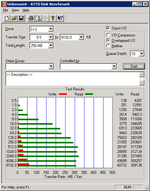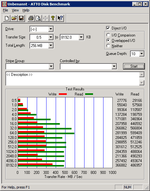Zur der Green, die gibts übrigens auch mit 32MB Cache .. aber das ist eh vollig egal.
Der Cache hat nur einen sehr sehr geringe Einfluss auf die Performance einer HDD

Wenn dann eh nur messbar nicht sprürbar.
Die Green ist halt optimal als Datenlager zu gebrauchen.
Leise, schnell genug, vibrationsarm und eher kühler als ihre Kollegen
Zum Thema Spindeldrehzahl:
Faceoff at One Terabyte: Seagate's Barracuda ES.2 and WD's Caviar GreenPower
The manufacturer is careful in not directly citing spindle speed, instead nominally positioning the Caviar GP as a "7200 RPM-class" drive. Under its "IntelliPower" moniker, WD claims a "A fine-tuned balance of spin speed, transfer rate and cache size designed to deliver both significant power savings and solid performance." Some folks have misinterpreted some admittedly vague specs on WD's website. Under "Rotational Speed," the manufacturer cites "IntelliPower (5400 to 7200 RPM)." This does not mean the drive dynamically changes its spindle speed during operation... indeed, such a feature would entail considerable mechanical engineering and would in many ways defeat the point -- rapidly accelerating and decelerating the spindle's speed would increase rather than decrease net power draw. Rather, the IntelliPower term indicates that the GP family as a whole does not have a set spindle speed (nor a set buffer size, for that matter). Different capacity points may feature differing spin speeds and buffer sizes. For those that must know, WD admits "sub-6000 RPM operation" for the 1-TB Caviar GP (more on this on the following page).
We have to take a different approach when assessing the Caviar GP's seek time since WD does not explicitly give users the drive's spindle speed. The GP turns in a measured access time of 15.0 ms, a score that lags the 7200-RPM WD7500AAKS by a significant margin. The WD7500AAKS's measured seek time when accounting for 4.2 ms of 7200 RPM latency is 9.5 ms (missing the firm's claim by over half a millisecond). Assuming the GP also shares such a seek time, that leaves us with 15 ms [measured access time] minus 9.5 ms [assumed seek time] which equals 5.5 ms, almost exactly the rotational latency associated with a 5400 RPM spindle speed.
The Caviar GP's outer-zone score clocks in at 79.8 MB/sec and as a result lags the older, less dense WD7500AAKS by 21%. Assuming similar sector-per-track zone configurations, a 7200 RPM drive would boast a 33% advantage over a 5400 RPM unit. The difference between the GP and the WD7500AAKS is less than that, likely of course due to a density advantage on the GP's part. Nevertheless, this second low-level diagnostic again suggests a 5400 RPM spindle speed.
Die WD Blue ist die Mainstream HDD von WD .. taugt für alles: System und Datengrab!
Also ein optimaler Kompromiss Aus Leistung und Lautstärke etc.
Die Black soll etwas lauter zu Werke gehen, dafür aber auch etwas flotter wie die Blue und Green sein. (siehe Sammelthread)
Kostet mehr hat aber auch 5 Jahre Garantie.
Entscheide also, für was die HDD eingesetzt werden soll und wie wichtig dir die Lautstärke etc der HDD sind

Samsung gibt die 7 Jahre Garantie übrigens nur auf ihre RAID Laufwerke.
Diese haben eine angepasste Firmware für den RAID Betrieb, so lange Du die HDD also nicht im RAID einsetzt nicht zu empfehlen






